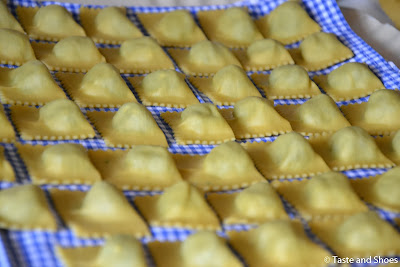I am and I will be missing for this month, due to a journey and very busy days at work and at home. My apologies will be few posts but hopefully good. Less is more!
And that's why the topic of this post is a great, traditional dish: Green Tortelli.
In questo mese di luglio sono e sarò un po' latitante, complice una vacanza e tante cose da fare, al lavoro e fuori. Per farmi perdonare, cercherò di postare poche cose ma buone. Less is more!
Eccomi allora a raccontare un altro grande primo della tradizione emiliana: i tortelli verdi.
Actually, there's not just one name for them, neither a single shape: it depends on the area you go. The most popular name is ravioli, but you can find them also as tortelloni, cappellacci and, in my place, tortelli. Tortelli are square-shaped and not too big, let's say that you might hardly need to cut in half to eat them in a bite. This is true for homemade tortelli, in restaurants they are usually bigger. But this is not a big deal, the right balance between pasta and the stuffing is what really matters.
Come sempre, non esiste un nome solo con il quale vengono definiti, nè tantomeno un'unica forma: dipende dalla zona. Il nome più diffuso in Italia è ravioli, ma li troverete anche come tortelloni, cappellacci e, nella mia zona, tortelli. Qui sono di forma rettangolare di media dimensione, diciamo che al massimo devono essere tagliati in due parti per essere mangiati in un boccone. Questo vale per quanto riguarda quelli fatti in casa, nei ristoranti generalmente tendono ad essere più grossi. Ma poco importa se le proporzioni di pasta e ripieno sono equilibrate.
I won't talk about the Sfoglia, which is not a simple dough but a fundamental ingredient, and I already praised her (I hope successfully) in this post. Let's move on to the other basic element: the stuffing. Green stuffing is the most popular version, indeed. And here's a straight link to traditional cookery and common habits. Tortelli were (and still are) a dish prepared on sunday, on feast days, but as they do not contain meat, they were prepared actually quite often. In winter they were made with spinach, in summer with chards. Personally, I prefer the chard version, more delicate and mild.
Non mi soffermo più di tanto sulla sfoglia, più che una pasta è come se fosse un ingrediente/materia prima di base, e l'ho già elogiata (spero di esserci riuscita) in questo post. Passo subito ad uno degli elementi fondamentali: il ripieno. La versione più diffusa è quella con il ripieno verde, appunto. E qui si apre un mondo, uno specchio della storia e della cultura. I tortelli erano (e sono) considerati un primo della domenica, della festa, ma poichè privi di carne erano un piatto preparato con più frequenza. In inverno con gli spinaci, in estate con le erbette. Personalmente li preferisco con le erbette, hanno un sapore più delicato.
An other important ingredient is the ricotta cheese: the amount of this cheese increases in the stuffing as much as the altitude of the place where it's prepared; down to the city it's totally absent, up to the Appenins it's a must. In this case I prefer the version with ricotta, but I guess is because I'm used to.
At last, the dressing: tortelli are usually served with melted butter (or even better if dabbed on each single tortello) and grated parmesan (which is also used in many recipes for the stuffing). Sometimes they are served also with some rich sauces, which I prefer with other versions, like potato tortelli.
Altro elemento presente è la ricotta: aumenta la percentuale di ricotta nel ripieno con l'aumentare dell'altitudine; in pianura è un ingrediente totalmente assente, mentre sugli Appennini non può mancare. In questo caso li preferisco di gran lunga con la ricotta, ma immagino sia una questione di abitudine.
Infine, il condimento: solitamente si arricchiscono con burro fuso (o megli ancora tamponato/picchiettato direttamente su ciascun tortello) e parmigiano grattugiato (di solito presente anche nel ripieno). A volte vengono serviti anche con la salsa al soffritto, che però personalmente preferiscono con altri ripieni, come ad esempio con i tortelli di patate.
Once again the choice of ingredients and the territoriality are bonded together to reveal the magic of the Italian poor cookery, not poor at all, but actually full of ideas and meaning. People used what was available, nevertheless they made out great recipes.
And I'll finish off with a very difficult question: better Cappelletti or Tortelli? (I choose tortelli).
Ecco dunque come il forte legame tra la scelta degli ingredienti e la territorialità rivela tutta la magia della cucina povera italiana, dove di povero c'è ben poco, specialmente nelle idee. Si usava ciò che si aveva a disposizione, nonostante ciò si era in grado di ricavare grandi piatti.
Finirò con una domanda difficilissima: meglio i tortelli o i cappelletti? (io scelgo i tortelli).
Buon appetito!






0 commenti:
Posta un commento